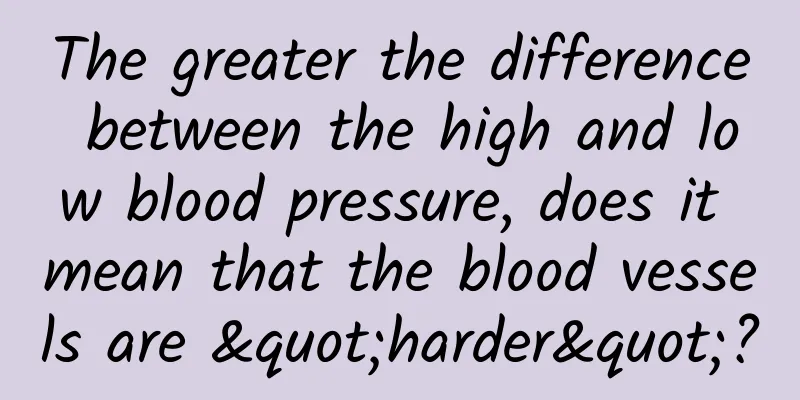The greater the difference between the high and low blood pressure, does it mean that the blood vessels are "harder"?

|
A friend told Huazi that his systolic blood pressure is about 160mmHg, but his diastolic blood pressure is only 70mmHg, with a pressure difference of 90mmHg. Why is this so and what should he do? Hua Zi said that the difference between high and low blood pressure is usually 30-40 mmHg, and normally does not exceed 60 mmHg. If the difference is too large, it means that the large arteries have hardened, and the larger the difference, the higher the degree of arteriosclerosis. After discovering arteriosclerosis, the most important thing to do is to control blood pressure. 1. The greater the pressure difference, the "harder" the blood vessels. The blood flow in the human body is powered by the beating of the heart and circulates in the blood vessels. When the heart contracts, it pumps blood into the aorta, which then expands elastically to accommodate the blood. At this time, the blood exerts pressure on the aorta wall, and the maximum value of this pressure is the systolic pressure (high pressure). When the heart relaxes, the aorta begins to shrink under its own elasticity. At this time, the aortic valve closes to prevent blood from flowing back to the heart, and the blood is pushed to the peripheral arterioles. At this time, the aorta wall exerts pressure on the blood, and the minimum value of this pressure is the diastolic pressure (low pressure). It can be seen that the elasticity of the aorta is closely related to the level of blood pressure. When the elasticity of the aorta decreases and hardens, the resistance of the heart during contraction and pumping blood will increase, which is manifested as an increase in high blood pressure; during diastole, due to the lack of elasticity of the aorta, the retraction force is weakened, which is manifested as unchanged or reduced low blood pressure. Factors that lead to hardening of the large arteries are mainly related to age, so this type of blood pressure, where the high pressure increases, the low pressure remains unchanged or decreases, and the difference between the high pressure and the low pressure increases, is more common in the elderly and is a typical feature of hypertension in the elderly, also known as isolated systolic hypertension. And the higher the degree of arteriosclerosis, the greater the pressure difference. 2. Controlling blood pressure is the key to delaying arteriosclerosis. When arteries lose their elasticity and become hardened, blood pressure will gradually rise, and high blood pressure will in turn aggravate the progression of arteriosclerosis. The two are mutually causal, forming a vicious cycle. Arteriosclerosis is an inevitable trend of human aging. We cannot fight aging, but we can delay the progression of arteriosclerosis by controlling blood pressure. Moreover, hypertension is a "breeding ground" for various cardiovascular and cerebrovascular diseases such as cerebral hemorrhage, cerebral infarction, coronary heart disease, myocardial infarction, etc., so blood pressure must be controlled within the normal range. For the treatment of isolated systolic hypertension, the current internationally popular approach is to focus on controlling high blood pressure and ignore low blood pressure. However, based on clinical experience, if the low blood pressure is too low, hypotensive perfusion syndrome may occur, causing damage to important organs such as the heart, brain, and kidneys. Therefore, it is recommended that the low blood pressure value should still be taken into account during the blood pressure reduction process and should not be too low. For people with large blood pressure differences, mainly the elderly, the blood pressure should not be lowered too quickly. If you are over 65 years old, the initial control target for high blood pressure can be temporarily set at 150mmHg, and then gradually reduced to 140mmHg. If you can tolerate it, continue to reduce it to around 130mmHg. During the blood pressure reduction period, pay close attention to low blood pressure and try to control it above 60mmHg. If you experience ischemic symptoms such as dizziness, black vision, and palpitations during blood pressure reduction, you should reduce the dosage and maintain a slightly higher blood pressure value. 3. Large pressure difference and the choice of antihypertensive drugs. Isolated systolic hypertension in the elderly with a large pressure difference is usually sensitive to sodium ions and belongs to volume-type hypertension. The effect of diuretics is more significant. They can reduce blood volume by excreting sodium and water. Long-term use can also reduce the body's sodium ion level, reduce vascular excitability, dilate blood vessels, and produce a antihypertensive effect. However, the blood pressure-lowering effect of diuretics alone is relatively weak, and it is difficult to reduce blood pressure to the normal range when used alone. Therefore, the commonly used regimen now is to use diuretics as the basis, combined with diazepam, lol, pril or sartan. Most people need at least two drugs to stably control blood pressure. To sum up, the high pressure in blood pressure increases, the low pressure is low, and the pressure difference becomes larger, indicating that the large arteries have hardened. The larger the pressure difference, the harder the blood vessels are to a certain extent. By controlling blood pressure, the progression of arteriosclerosis can be slowed down. When taking medicine, the doctor needs to choose according to the underlying disease, sensitivity to the medicine and other factors. If you have any questions about the use of medicine, please consult a doctor or pharmacist in time. I am pharmacist Huazi. Welcome to follow me and share more health knowledge. |
>>: What are the functions and uses of concave-convex mirrors? Principle of concave-convex mirrors
Recommend
Will adult constipation affect the baby?
Constipation is a very uncomfortable thing. It is...
Bleeding after having sex after menstruation
Bleeding after having sex right after the menstru...
What's wrong with no water during sex?
When you get older and get married, you will star...
How to regulate women’s Yin deficiency and excessive fire? Eating these has good effects!
Once a woman suffers from Yin deficiency and exce...
Can I detect pregnancy after 30 days of amenorrhea?
In life, many expectant fathers and mothers, when...
Is pelvic fluid blood?
There are two types of pelvic effusion, one is pa...
What should you pay attention to during the confinement period?
The short confinement period is what we usually c...
One picture to understand | Damaging the environment: a new reason to quit smoking
May 31, 2022 is the 35th World No Tobacco Day. Th...
Can virgins also suffer from gynecological inflammation?
For women who have had sex, the probability of de...
Can I have sex the day before my period?
Women's menstruation is very special because ...
[Medical Q&A] What is the difference between psoriasis and onychomycosis?
Planner: Chinese Medical Association Reviewer: Sh...
What does ginkgo nut look like? How to prepare ginkgo nut for consumption?
Ginkgo nuts, commonly known as white nuts, can be...
How to choose carambola? Can carambola be drunk in wine?
Star fruit, also known as carambola, is a tropica...
How to deal with vulvar itching during pregnancy
During pregnancy, women will experience various d...
Troubles of patients after surgery for lung carcinoma in situ
This is the 3907th article of Da Yi Xiao Hu Lung ...









